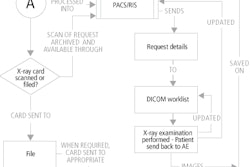ORLANDO, FL - Despite explosive growth in the radiology market and extensive discussions about electronic health records (EHR) and enterprise-wide clinical systems integration, PACS technology remained elusive at the 2004 edition of the Healthcare Information and Management Systems Society meeting.
Information technology (IT) specialists walked 16 miles of carpet, viewing wares from almost 800 vendors. Yet fewer than 50 of these displays were related to PACS or technologies used in PACS. Of these 50 vendors, fewer than a handful had booths that were dedicated exclusively to PACS, with the remainder including PACS in part of the broader presentation of integrated clinical systems.
And even though 200 presentations and papers were given, only a handful addressed digital imaging, with a majority of them focused on telemedicine versus PACS. Simply put, PACS not only failed to catch the bouquet once again at HIMSS, but it had to wrangle an invitation to the wedding so it could even try.
Why is PACS still a bridesmaid? The reasons are many. Until recently, the cost-benefit ratio of PACS wasn't clearly understood, and as a result, PACS networks were never widely implemented. Those that were installed were often radiology-centric solutions implemented by cutting-edge imaging departments. PACS has never really had IT support until recently either, remaining primarily a radiology-driven project.
In recent years several vendors have caught the attention of chief information officers by advancing the concept of an enterprise-wide clinical patient record (CPR), integrating electronic medical records (EMR) with other systems including laboratory, pharmacy, pathology, RIS, and PACS. Further helping to advance this trend is the rapid growth of digital cardiology imaging systems, and with them cardiology PACS.
With local and wide-area networks no longer presenting the barriers they once did (gigabit pipes have become de rigueur) and storage-area networks (SANs) supplanting traditional archive media like WORM (write once, read many), magneto-optical disks (M/O D) and even newer DVD archives, the move towards PACS has suddenly become a driving force behind system-wide clinical systems implementation.
Add to this the increased processing power and lower cost of desktop PCs, and incorporation of the JPEG 2000 compression standard, which speeds up the delivery of images to the desktop using industry-standard data compression, and you have a situation ripe for development. The thought process within the CIO community seems to be that if the infrastructure required for PACS, with its large image file and database requirements, is strong enough to support PACS, how much more effort would it take to support other clinical systems as well? The answer is, not a whole lot more.
It takes a new understanding of the role PACS plays in an enterprise-wise solution to make PACS work properly, though. That understanding, with few exceptions, still hovers mostly at the 30,000-foot level within IT. Since PACS employs computer technology, upper-level hospital administrators are now requiring the hospital’s IT department to give PACS its blessing before a vendor is selected and implemented.
That said, it is unfortunate that very few IT managers have the knowledge base to discern the differences between the systems being evaluated, at least from a clinical perspective. Those who do often have neither the time nor resources to assist in the decision-making process in any great detail unless it is made a priority by those above them.
IT still tends to look at PACS from a technology perspective rather than the applications level from which PACS really should be evaluated. Form without function equals failure. PACS needs to be looked at from multiple levels, however, not just one.
Shows like HIMSS could easily help educate the IT managers who are clamoring for information, yet the information offered at the conference is light on detail. While HIMSS is not designed to supplant the Symposium for Computer Applications in Radiology (SCAR), the 20,000+ HIMSS attendees should at least leave the show with more information about PACS beyond PACS 101.
HIMSS, however, should be given some credit for finally showing the integration of IHE (Integrating the Healthcare Enterprise) and HL7 (Health Level Seven) with an interoperability demonstration, even though these have been demonstrated at the RSNA conference for the past four years running. Again, though, it’s a start.
It was interesting to see how the big five radiology PACS players (Agfa HealthCare, GE Healthcare, Eastman Kodak Health Imaging, Philips Medical Systems, and Siemens Medical Solutions) positioned their PACS as part of a global integrated clinical system. Equally interesting was how the major RIS vendors (Cerner, Eclipsys, IDX Systems, McKesson Information Solutions, and Meditech) and independent PACS vendors positioned their systems and relationships. DR Systems, for example, strongly referenced its relationship to Meditech, while Stentor and IDX cross-identified with each other.
Amicas and Algotec referenced parents VitalWorks and Kodak, respectively, while Brit Systems addressed its relationship to IBM, and Eclipsys its new OEM relationship with software provider Sectra Imtec. Fujifilm Medical Systems USA and Emageon elected to demonstrate PACS as standalone solutions.
There was heavy emphasis on voice recognition (VR) systems, with over two dozen vendors showing VR technology. The technology is used not just by radiology but by emergency room physicians and other clinical areas, including note-taking applications for physicians and nurses. A recent study referencing answers from over 300 healthcare executives showed that 53% plan to start using VR systems in the next two years. Once context-based VR takes hold in another few years, VR will become the practice standard within radiology, supplanting transcription-based systems.
It never ceases to amaze me that, just as at the RSNA conference, IT companies tout their ratings in the KLAS survey, even though there is no rhyme or reason to the rankings. Unlike in radiology, the rankings here are used almost vindictively, with negatives emphasized in the story boards rather than the positives as found in radiology.
Nearly 72% of IT managers recently surveyed indicated that their IT budgets would be increased in FY 2005. Yet another study indicated that by 2006 nearly 30% of all hospitals in the U.S. will have implemented PACS, although this figure may be skewed by how PACS is defined by various enterprises. Still, increased IT budgets and increased PACS implementations should serve as a catalyst for vendors becoming an information resource for both IT and radiology types alike.
By Michael J. CannavoAuntMinne.com contributing writer
February 27, 2004
Related Reading
The year of the Uni-PACS: A view from the RSNA floor, December 11, 2003
The PACSman’s opinionated view from RSNA 2003, December 4, 2003
The PACSman’s opinionated view from RSNA 2002, December 4, 2002
Stop me if you’ve heard this one about PACS, November 29, 2001
RSNA 2000: The PACSman Awards, November 30, 2000
Copyright © 2004 AuntMinnie.com
Editor’s Note: Michael J. Cannavo is a leading PACS consultant and has authored over 250 articles on PACS technology in the past 15 years. The comments and observations expressed herein do not necessarily reflect the opinions of AuntMinnie.com, nor should they be construed as either an endorsement or admonishment of any particular vendor. Instead they should be taken as personal observations from a guy who has, by his own account, been in this industry way too long. Mr. Cannavo can be reached via e-mail at [email protected].


















